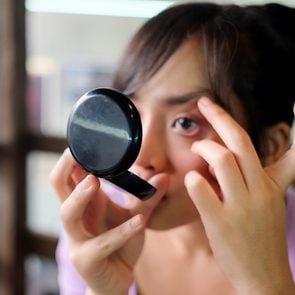This 38-Year-Old’s Deteriorating Vision Stumped Doctors. What Tests Revealed is the Stuff of Nightmares

For weeks, an eye parasite had been tunnelling, undetected, through the Ontario woman’s macula. Read the true story of how doctors stopped at nothing to save her eyesight.
After the pandemic hit in 2020, Nida Shahzeb, a 38-year-old social-media specialist in Mississauga, was busier than ever—working from home while looking after her three children, aged 11, eight and five. When spring arrived, they spent as much time as they could playing in their backyard, where Shahzeb was planting a garden.
One evening in June, Shahzeb briefly closed her right eye while using her iPad. When she did, she noticed something odd about the vision in her left eye.
“The screen was hazy and shadowy,” she recalls. She assumed her eye was tired, but the next morning, the problem was still there: greyed-out spots in her central vision. The eye wasn’t sore or red, but after a couple of days she listened to her gut—and her GP—and headed to the emergency room.
The ER physician who examined her was mystified. He gave her an urgent referral to an ophthalmologist, who would have more expertise. Shahzeb went immediately.
Looking for answers
After dilating her pupil, the doctor spotted inflammation in the retina and suspected Shahzeb had white dot syndrome—a category of eye disease characterized by lesions deep in the retina—but couldn’t determine any reason why. She told Shahzeb that she needed to see a specialist in diseases of the retina—and quickly.
By now, Shahzeb was frantically reading everything she could find online about eye diseases. “All day long I was worried about it,” she says.
The next day, she visited Dr. Netan Choudhry, medical director at Vitreous Retina Macula Specialists of Toronto. Choudhry explains the urgency: “When you’re experiencing a vision lapse and you don’t know why, you need to make a move. There’s a concern it’s rapidly progressive.”
White dot syndrome has a variety of suspected causes, including viruses, autoimmune disease, even lymphoma, and while some conditions improve on their own, others can result in permanent vision loss without treatment.
If you show any of these symptoms, you need to see an eye doctor.
Was it just an inflamed retina?
Using optical coherence tomography, which applies light like an ultrasound to take high-resolution images of the retina, the medical team determined that Shahzeb’s macula—the critically important central area of the retina—was inflamed. Since Shahzeb was young and healthy, a likely trigger was a virus, in which case she just needed a course of steroids to settle the inflammation. Choudhry prescribed the medication and told Shahzeb he’d recheck her in a few days.
In the meantime, Shahzeb struggled to focus on the computer screen. She stopped wearing her glasses, which exacerbated the problem. It seemed her vision was deteriorating further, but she recognized that might have been her feeling anxious. “It could have been my brain messing with me!” she says.
After a few days, she returned to Choudhry’s office. This time, the testing was even more extensive. One potential cause was a tiny parasite, but if indeed that was the cause, it was well hidden. The team used multi-spectral imaging, which shines lights of different wavelengths, allowing doctors to see deep layers of the retina.
An unexpected finding
When Choudhry reviewed the images, he instantly realized they’d found what they were looking for. There, on the macula, was a pale squiggle less than 2.5 millimetres in length. It was a roundworm. And since it changed positions between images, it was obviously alive.
For weeks, the parasite had been tunnelling, undetected, through Shahzeb’s macula. “It’s like a bulldozer moving through a forest. As it moves, it destroys,” says Choudhry.
Several species of tiny worms have been known to invade the human eye, although it’s rare, and in up to three-quarters of cases, the culprit isn’t visible on imaging tests. But one of the most common species, a roundworm called Baylisascaris procyonis, is also one of the largest and most devastating.
Choudhry had previously asked Shahzeb about contact with raccoons and cats—both can occasionally transmit Baylisascaris to humans—but Shahzeb had brushed it aside. Questioned again, though, Shahzeb recalled disposing of raccoon feces she’d found in her backyard garden, about a month before her symptoms had appeared. She used gloves for the job, but Choudhry says that wouldn’t have prevented a Baylisascaris egg from entering Shahzeb’s body through her respiratory system.
Shahzeb held her emotions in check until she got to the car, where she broke down and cried as her husband pressed her to tell him what was wrong.
Treatment options were dwindling
As long as the worm stayed near the surface of the retina, it could probably be removed. Choudhry arranged for Shahzeb to see Dr. Efrem Mandelcorn at Toronto Western Hospital the next day. But new scans showed that the parasite had burrowed deeper in just 12 hours. Removal was no longer an option without damaging Shahzeb’s eye.
Mandelcorn had no choice but to kill the worm by overheating the area with a thermal-laser instrument and leave it in the eye. Its body would eventually disintegrate, but its species would never be known for certain. Three days later, at a follow-up appointment with Choudhry, Shahzeb was relieved to learn the worm was no longer moving.
Shahzeb still has blotted-out areas in her central vision, but as her brain has adapted, it has learned to fill in some of the gaps, and she doesn’t notice the loss as much. There’s also a chance some cells will regenerate over time.
“I like to think my colleagues and I unravelled the mystery in time to rescue some vision,” says Choudhry. “If this had been left for months or longer, it could have gotten to the point where she saw no light at all.”
That gives Shahzeb goosebumps. “I’m just so grateful this was discovered and that I didn’t end up losing my eyesight to the point where I couldn’t function,” she says. There’s one activity, however, she won’t resume. “My mom said, ‘Don’t even think about going back in the garden!’”
Next, read the incredible story of how a woman’s X-ray revealed the reason behind her life-long stomach pain.






